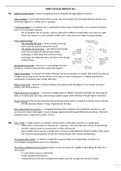IOB3-3-22 Data (2022/23 Q1)
M2 Digital transformation is about changing practices of people through digital innovation.
Data ecologies = sets of distributed data sources that meaningfully link data generated by human and
nonhuman agents to a design aim or purpose.
A wicked problem is a problem that is multifaceted where lots of stakeholders are involved and where
there is no one proper solution.
- We as designers do co-creation sessions with all the different stakeholders and users to make
these new system in a very valuable matter and in that sense we shape the data ecology.
-
Data-enabled design
- The everyday life loop -> where people are doing
their practices and executing their work.
- The design research loop -> we observe the people
from the everyday life loop and we embed
prototypes in their daily lives and from those
prototypes and daily practices, we learn in the design
research loop.
Sociotechnical system = structure or assemblage that span
hardware, software, personal and community aspects.
Digital innovation = a creation of market offerings, business processes or models that result from the use
of digital technology driven by the efforts of carrying out new combinations of digital and physical
components to produce new market offerings.
Digital materiality = dynamic interface between the physical and the digital in the context of human
activity and social practices.
Organizational convergence = a popular strategy based on digital innovation leverage the advantage of
ideas to include open sourcing, outsourcing or global supply chain alliances through digital innovation.
Social practices entail human practices that people generally tend to recognize as being cultural familiar.
- APTOD (Activity, People, Things, Organizations & Data)
Data augmented user journey = a mapping technique that combines the traditional customer or user
journey as has been developed in service design augmented with (quantified) data produces, infused or
impacting users, experiences and/or choices.
M3 Data model = A data model is an abstract representation of the data relevant to a design goal.
- Abstraction is the process of filtering out – ignoring – the characteristics of the mini-world that
we don't need in order to concentrate on those that we do.
- Data models can be used as a design tool, to help us understand the design problem, think about
the structure and properties of data and communicate with relevant stakeholders.
Conceptual data model = an abstract model that captures data and relationships concepts in a
technological-independent manner for databases.
The entity-relationship (E-R) model provides a series of constructs capable of describing the data of a
mini-world:
- In a way that is easy to understand
- Using a graphical formalisms
- Independently of the data management system used for storage and retrieval of data
1
, Entities are classes of objects having common properties and autonomous existence.
- A relationship is a set of associations among instances of these entities.
- Entity-relationship diagram = graphical representation of data models
depicting their entities, relationships and attributes within an strict notational
scheme.
Structural constraints:
- Cardinality describes the maximum and minimum number of relationship
instances in which an entity instance can participate, specified for each entity participating in a
relationship (1:1, 1:N, N:M).
- Maximum (cardinality ratio) can be
o 1: each occurrence of the entity is associated at most with a single instance of the
relationship
o N: each occurrence of the entity is associated with an arbitrary number of instances of
the relationship
- Minimum (participation constraint) can be
o 0: the participation in the relationship is optional or partial
o 1: the participation is mandatory or total (existence dependency)
Different types of relationships:
- 1:1 (one-to-one relationship) = One entity on one site, one entity on the other.
- 1:N (one-to-many relationship) = One entity on one site, N entities on the other.
- N:M (many-to-many relationship) = one instance of entity A, there exists zero, one, or many
instances of entity B; and for one instance of entity B, there exists zero, one, or many instances
of entity A.
Attributes describe the elementary properties of entities or relationships which characterizes or
describes them in some way.
Data model quality:
- Correctness: use the most appropriate model constructs.
- Completeness: all the concepts of interest are represented.
- Minimality: all the relevant concepts are represented once in the schema.
o No redundancies
- Readability: the model represents the mini-world in a way that is easy to understand.
M4 Data = Units of information, collected through observations.
- Single value | variable (number of residents) and multiple values | variables (set of populations)
- Quantitative (sensor measurements, etc.) and qualitative (articles, interviews, etc.)
Dataset = A collection of separate units of information that altogether constitute a single new unit.
- A dataset consists of data points (=units of information, usually collected through observations
by people or machines). Data points can be of various data types, both qualitative or
quantitative.
- For a dataset to be considered ”open” it should be: openly available, free to use and re-use and
shareable by anyone, anytime, anywhere
- An open dataset should comply with two main characteristics:
o Legally available: Explicit licenses that permit commercial & non-commercial use and re-
use (e.g. PDF)
o Technically available: Available in a machine-readable standard form (e.g. XLSX)
- Other data characteristics:
o Granularity = level of detail in a data structure.
▪ Spatial granularity (= level of detail in relation to the partition of space) and
temporal granularity (= relates to the partition of time).
o Accuracy: measures how close the data is to the truth.
2




